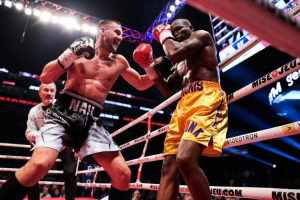Featured Articles
Life After DOOMSDAY: Assessing the Career of “Superman” Stevenson

On December 1, 2018, the five-year reign of Adonis “Superman” Stevenson came to a violent end in the eleventh round of a WBC light heavyweight title fight in Quebec City, Canada. The 41-year-old defending champion was battling to make the tenth defense of the world championship he’d won in 2013 with a shocking first round knockout of “Bad” Chad Dawson in Montreal.
Hammered into defeat so severely by new champion Oleksandr “The Nail” Gvozdyk, Stevenson was hospitalized where he spent six weeks in an induced coma to save his life.
To his haters on Twitter and beyond, this was welcomed as overdue karma—poetic justice. To everyone else, it was seen as a great fight up for grabs before Gvozdyk grabbed the victory.
Support from within the global boxing community for the wounded pugilist has been positive and encouraging. That same dynamic is happening again on social media for Errol “The Truth” Spence Jr., the welterweight champion injured in a car wreck last Thursday in Dallas, Texas.
Now in long-term recovery while healing from a boxing-related brain injury, the boxing life of Adonis “Superman” Stevenson is officially over. His career is a closed book. Let’s review it.
TRUTH AND JUSTICE
Born in Port-au-Prince, Haiti in 1977, Stevenson immigrated to Canada with his family in 1984. Writing last year for The Fight City online, author Ralph M. Semien illustrates what followed:
“By 14 he was out of control, spending time on the streets, and soon enough he was part of a violent gang and headed for disaster. Eventually he became involved in an organized sex-for-hire service in Montreal. Stevenson was arrested, tried, convicted and he served his jail time. When released from prison in 2001, he made a pact with himself to turn his back on the street gang lifestyle and everyone associated with it, that he would never again break the law.”
GRAPHIC NOVEL
Five years later in 2006 after a successful campaign in the amateurs where he boxed at middleweight for Canada and won a pair of national titles for his new country, Stevenson turned professional at super middleweight under the promotional guidance of Yvon Michel. His was your typical boxing story of overcoming a troubled past to carve out a brighter, better future.
He ran his record to 13-0 against gradually increasing competition before a 2010 setback TKO against so-called journeyman Darnell Boone. Buzzed late in the opening frame by a sneaky right uppercut and a hard left hook, Stevenson was easy pickins for Boone early in the second round.
A year later, Stevenson returned to the ring; winning six fights and a few minor super middleweight title belts. Most importantly during this transitional period in his career, Stevenson avenged his upset loss to Boone, punishing “Deezol” before knocking him out cold in the sixth.
“He definitely got better and earned his spot,” concedes Boone.
When an opportunity came to fight for the WBC light heavyweight title in 2013, Stevenson took full advantage, putting Chad Dawson down and out with a single, lethal left hook to the chin. The reign of Superman was up, up and away and boxing seemed to welcome its new action hero.
But not so fast, speeding bullet.
American fans and media never let Stevenson forget about his checkered past as a convicted street hustler. And if all that wasn’t enough, soon they were labeling him a “ducker” and a “cherry picker” for his apparent refusal to fight Sergey Kovalev and/or Eleider Alvarez.
Despite the constant negative press painting him as the bad guy, he was actually a very likeable man with a huge smile. Stevenson was also wildly popular in Canada and his title fights were entertaining events where more often than not, he left opponents twitching in a mangled heap.
Unsatisfied with Stevenson’s choice of title challengers, Oscar De La Hoya’s The Ring magazine in 2015 officially withdrew (stripped) its recognition of Stevenson as the “real” World Light Heavyweight Champion. To the Bible of Boxing, Stevenson was an unrepentant sinner.
By that point, Stevenson had made six defenses of his WBC light heavyweight title with wins against Tavoris Cloud, Tony Bellew, Andrzej Fonfara, Dmitry Sukhotskiy, Sakio Bika and Tommy Karpency. That super-fight with “Krusher” Kovalev never happened and it never will.
Who’d have won?
Does it even matter anymore?
I’ll give common opponent Darnell Boone the last word on it. “Kovalev. Because he’s the more sound boxer. Adonis did the same thing in every fight. Paw with the jab, paw with the jab, left.”
“He never really mixed it up,” insists Boone. “Kovalev is throwing combinations. He’s moving, punching off the angles. He knows exactly how to use his height and leverage with his punches. Kovalev keeps you on the outside, away from getting on the inside on him. He fights tall.”
That’s all true but was there more to Stevenson’s game than just predictable one-punch power with the left hand? Trained by Javon “Sugar” Hill, Stevenson was a KRONK fighter. He improved as he got older and deeper into his profession. His southpaw offense was almost always good enough to be his defense. Trading with him was suicidal. And as a body puncher, he was underrated.
In 2016, he knocked out Thomas Williams Jr. with a viciously quick left hook. In 2017, he rematched Fonfara and blew him away in two rounds. In 2018, before the Doomsday loss to Gvozdyk, there was a grueling, disputed draw with super middleweight Badou Jack.
I had Stevenson up by a point in a war that should’ve garnered more consideration for Fight of the Year honors. Unfortunately, the anti-climactic draw took some of the shine off a classic.
If only the Al Haymon-handled fighter had been more willing to mix it up with the big names, critics would probably be more kind to him today, especially if he’d beaten Kovalev, something that doesn’t exactly look like an impossibility when looking back at the proposed match-up.
Against Ward and Alvarez, Kovalev showed susceptibility to a determined attack, particularly to the body. In his penultimate fight against “The Ripper” Jack, Stevenson put the kind of hurt on Badou’s body late in the fight that may have been very difficult for Kovalev to overcome.
THE ADVENTURES OF SUPERMAN
How should Stevenson be viewed in the light of light heavyweight history? Keep in mind that not everybody was so thrilled to get in the ring with him. Edwin “La Bomba” Rodriguez spoke for years of facing him “in the future” but in the end it was all just talk. After Rodriquez was knocked out by Williams Jr. in 2016, Williams Jr. was knocked out by Stevenson three months later.
Though he’ll never be rated as one of the all-time greats in the weight class, Stevenson should be recognized for what he actually was. Not just a champion, Stevenson was THE champion.
He beat the man who beat Bernard Hopkins. He was a one-punch power puncher, an action fighter, a defending world champion until he could defend that world championship no more.
Along the way, Stevenson picked up a Fighter of the Year award in 2013 while many of his knockouts were considered Knockout of the Year candidates. He was the WBC light heavyweight champion for sixty-six months, an unusually long time in today’s watered-down era of weight jumping and belt dumping. He retained his world title nine times, with only Bika, Fonfara, and Jack going the distance. Stevenson’s final record is 29-2-1 with 24 KO’s.
DOOMSDAY CLOCKED
And so with the Teddy Atlas trained Gvozdyk beating him senseless in the corner last December, boxing’s ultimate kryptonite (time) finally caught up to Superman Stevenson but not before the Haitian sensation made his improbable impact on the modern boxing landscape.

Stevenson’s desire to become a boxing champion probably saved his life while his desire to remain a boxing champion nearly cost him his life. We don’t yet know the final butcher’s bill.
What we do know is that Stevenson has had to relearn how to walk and talk. That’s how unpredictable and ironic this sport is: a PBC fighter supposedly protected by Al Haymon was nearly killed by an undefeated Ukrainian clearly up to the challenge of fighting (and beating) him.
Last week Stevenson uploaded a video on Instagram. He’s seen in the gym, moving on his feet, wearing a pair of pink boxing gloves while lightly working over a heavy bag as fiance Simone God and their new daughter Adonia look on. “I love you,” posted God to her miraculous man.
To review: Stevenson Adonis escaped his dying homeland before it imploded. He then crash-landed in Canada where he was adopted by the Canadian people. He did the crime(s) then he did the time; paying whatever debt he owed to society for his transgressions. He won and lost his battles by the power of his own fists. As a human being, he is truly transformed.
“Superman” Stevenson is dead.
Long live Adonis Stevenson…
EDITOR’S NOTE: After receiving this story, yet another boxer suffered a serious head injury. Patrick Day, a 27-year-old junior middleweight from Freeport, New York, was knocked out by Charles Conwell in the tenth-round last night on the Usyk-Witherspoon undercard and is now fighting for his life in a Chicago area hospital where he has been placed in a medically induced coma. On behalf of the entire editorial staff at The Sweet Science, I’d like to offer our thoughts and prayers for Day’s full recovery.
Boxing Writer Jeffrey Freeman grew up in the City of Champions, Brockton, Massachusetts from 1973 to 1987, during the Marvelous career of Marvin Hagler. JFree then lived in Lowell, Mass during the best years of Irish Micky Ward’s illustrious career. A new member of the Boxing Writers Association of America and a Bernie Award Winner in the Category of Feature Under 1500 Words, Freeman covers boxing for The Sweet Science in New England.
Check out more boxing news on video at The Boxing Channel
To comment on this story in The Fight Forum CLICK HERE
-

 Featured Articles4 weeks ago
Featured Articles4 weeks agoAvila Perspective, Chap. 330: Matchroom in New York plus the Latest on Canelo-Crawford
-

 Featured Articles3 weeks ago
Featured Articles3 weeks agoVito Mielnicki Jr Whitewashes Kamil Gardzielik Before the Home Folks in Newark
-

 Featured Articles1 day ago
Featured Articles1 day agoResults and Recaps from New York Where Taylor Edged Serrano Once Again
-

 Featured Articles4 weeks ago
Featured Articles4 weeks agoCatching Up with Clay Moyle Who Talks About His Massive Collection of Boxing Books
-

 Featured Articles5 days ago
Featured Articles5 days agoFrom a Sympathetic Figure to a Pariah: The Travails of Julio Cesar Chavez Jr
-

 Featured Articles3 weeks ago
Featured Articles3 weeks agoMore Medals for Hawaii’s Patricio Family at the USA Boxing Summer Festival
-

 Featured Articles1 week ago
Featured Articles1 week agoCatterall vs Eubank Ends Prematurely; Catterall Wins a Technical Decision
-

 Featured Articles4 weeks ago
Featured Articles4 weeks agoRichardson Hitchins Batters and Stops George Kambosos at Madison Square Garden





















